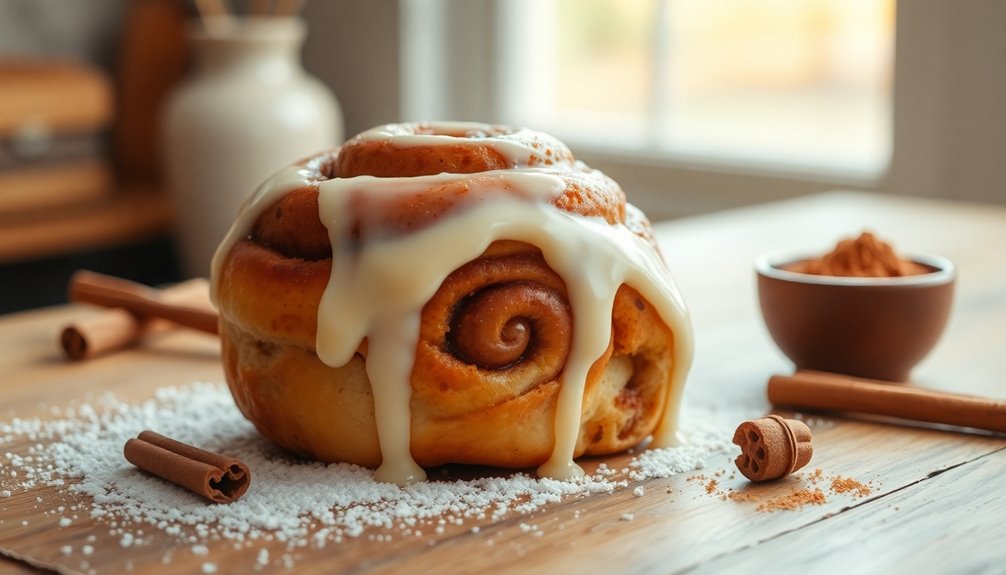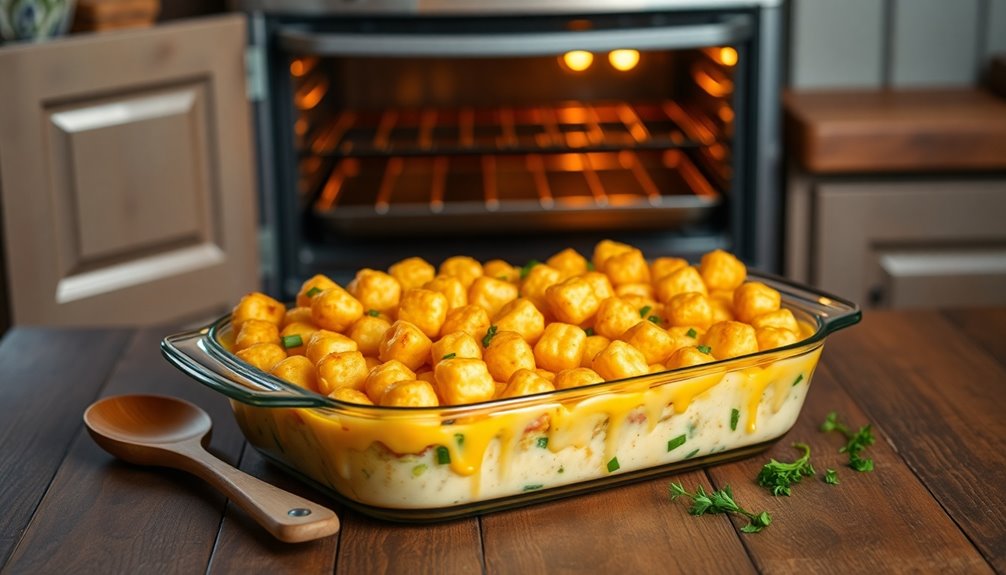When you think about cinnamon rolls, you might picture a warm, fragrant kitchen, the sweet aroma wrapping around you like a cozy blanket. It's fascinating how this simple recipe has evolved over the years, becoming a beloved staple in many households. You're probably eager to know the exact steps to achieve that perfect balance of soft dough and rich filling. But before we get into the specifics, let's take a moment to explore the history behind these delightful pastries and what makes them so universally appealing.
Key Takeaways
- Combine 4 cups of all-purpose flour, 1/2 cup sugar, and 2 1/4 tsp Platinum Yeast for the dough base.
- Activate yeast with warm milk and sugar, then mix in melted butter for moisture.
- Knead the dough until smooth, then let it rise in a warm place for 60-90 minutes.
- Roll out the dough, spread cinnamon and brown sugar filling, and cut into uniform rolls.
- Bake at 350°F (175°C) until golden, then drizzle with cream cheese frosting for extra flavor.
History

Cinnamon rolls have a fascinating history that dates back to ancient times, as people in Sweden and Germany began creating these delightful treats with enriched dough and spices like cinnamon and cardamom.
The modern version, particularly the "kanelbulle," emerged in 18th-century Sweden, where it became a celebrated pastry, even honored with a dedicated holiday on October 4th.
As immigrants brought their baking traditions to the United States in the 19th century, cinnamon rolls found a welcoming home in the Midwest.
The rise of commercial baking in the mid-20th century made pre-made dough accessible, allowing more home bakers to enjoy this breakfast favorite.
Today, cinnamon rolls are cherished worldwide, showcasing various regional adaptations and personal recipes.
Recipe

Cinnamon rolls are a delightful treat that can brighten up any morning or serve as a sweet dessert. This easy cinnamon roll recipe allows you to enjoy warm, fluffy rolls in just a fraction of the time compared to traditional methods, thanks to a single rise time of 60-90 minutes. With a few simple ingredients, you can create a batch that's sure to impress your family and friends.
The dough comes together with all-purpose flour, sugar, milk or buttermilk, butter, and an egg, resulting in a soft and pillowy texture. For the best rise and fluffiness, it's highly recommended to use Platinum Yeast from Red Star. Once baked, you can drizzle these rolls with your choice of icing—whether it's a rich cream cheese frosting or a light vanilla glaze, they'll surely be a hit.
Ingredients:
- 4 cups all-purpose flour
- 1/2 cup granulated sugar
- 1 cup milk or buttermilk, warmed
- 1/4 cup butter, melted
- 1 large egg
- 2 1/4 tsp Platinum Yeast from Red Star
- 1 tsp salt
- 1 tbsp ground cinnamon
- 1/4 cup brown sugar (for filling)
- Optional: cream cheese icing or vanilla glaze for topping
In a large mixing bowl, combine the warm milk or buttermilk and Platinum Yeast, letting it sit for about 5 minutes until foamy. Next, add the melted butter, sugar, egg, and salt to the mixture, stirring until combined. Gradually add the flour, mixing until a soft dough forms.
Knead the dough on a floured surface for about 5-7 minutes, then place it in a greased bowl, cover it with a damp cloth, and let it rise for 60-90 minutes in a warm place. Once doubled in size, roll the dough out into a rectangle, spread softened butter over it, sprinkle with cinnamon and brown sugar, and roll it tightly. Cut into 12 rolls and place them in a greased baking dish.
Let them rise again for about 30 minutes, then bake in a preheated oven at 350°F (175°C) for 20-25 minutes until golden brown. Drizzle with icing while warm.
For the best results, make sure your ingredients are at room temperature, especially the milk and egg, as this helps with the dough's rise. If you prefer to prepare the rolls ahead of time, you can assemble them the night before and refrigerate them overnight. Just remember to take them out to rise for a bit before baking.
Additionally, if you have leftovers, store them at room temperature for up to 2 days or freeze them for 2-3 months; simply reheat them in the oven for a few minutes before serving. Enjoy your delightful cinnamon rolls!
Cooking Steps

To kick off the cooking steps, you'll start by activating the yeast mixture in warm milk with sugar.
Next, combine the wet ingredients thoroughly before kneading the dough until it's smooth and slightly tacky.
Once you've got that down, let the dough rise in a warm place for the perfect texture.
Step 1. Activate the Yeast Mixture

Activating the yeast mixture is a crucial step in making your cinnamon rolls light and fluffy. To do this, combine ½ cup of warm water (between 105-115°F) with 2 tablespoons of sugar and 2 teaspoons of instant yeast.
Let it sit for about 5 minutes until you see bubbles or foam forming. The sugar feeds the yeast, ensuring a successful rise in your dough.
If you're using instant yeast, you can skip the proofing step and mix it directly with your dry ingredients. Just remember, the water shouldn't be too hot; temperatures exceeding 120°F can kill the yeast.
Once you see that frothy mixture, you're ready for the next step in your dough preparation!
Step 2. Combine Wet Ingredients Thoroughly

After your yeast mixture is ready, it's time to combine the wet ingredients thoroughly.
Start by warming your milk to between 100-110°F (38-43°C) and mix it with the melted butter, keeping the mixture warm but not hot.
In a separate bowl, whisk together the dry ingredients: all-purpose flour, sugar, and salt.
Slowly add the warm milk and butter mixture to the dry ingredients, ensuring everything blends well.
Next, crack in the egg and whisk until you achieve a uniform consistency.
Mix until a soft, slightly tacky dough forms, being careful not to over-flour.
This step is crucial for maintaining the fluffy texture of your cinnamon rolls, so make sure to combine wet ingredients properly before moving on.
Step 3. Knead Dough Until Smooth

Knead the dough until it transforms into a smooth, elastic ball. Use a lightly floured surface to prevent sticking, but avoid adding too much flour; you want it to remain soft and fluffy.
If you're kneading by hand, spend about 3 to 4 minutes working the dough until it feels elastic and slightly spring back when pressed. If you're using a stand mixer, knead on low speed for approximately 3 minutes, monitoring closely to prevent over-kneading.
This process ensures proper gluten development. Also, keep an eye on the dough's temperature; it should feel warm, not hot, as excessively warm dough can hinder yeast activity.
Once it meets these criteria, it's ready for the rising phase.
Step 4. Let Dough Rise in Warm Place

To achieve perfectly risen dough, find a warm, draft-free spot for it to rest.
You'll want to let the dough rise in an ideal warm environment, ideally around 75-80°F (24-27°C), to help it double in size effectively.
Cover the dough with plastic wrap or a clean kitchen towel to retain moisture, promoting a successful rise without forming a crust.
The first rise typically takes about 60-90 minutes, but keep an eye on it; you'll know it's ready when the dough doubles in size.
If your kitchen is too cool, consider placing the dough in an oven with the light on or near a heater.
Just be cautious not to over-proof the dough, as that can lead to dense cinnamon rolls.
Step 5. Roll Out the Dough

Once the dough has risen, it's time to roll it out on a lightly floured surface into a rectangle about 1/4 inch thick.
Using a rolling pin, start from the center and move outward, applying even pressure to avoid tearing the dough.
After you've rolled it out, spread the filling evenly across the surface, leaving a small border around the edges to prevent leakage when you roll it up.
Next, roll tightly from the long edge to create a uniform log, which helps maintain the shape of your cinnamon rolls.
Finally, use a sharp knife to cut the rolled dough into uniform pieces, ensuring clean cuts for even baking.
Enjoy your delicious cinnamon rolls!
Final Thoughts

As you savor the delightful results of your homemade cinnamon rolls, you'll appreciate the soft, fluffy texture paired with that irresistible gooey cinnamon sugar swirl.
The success of these rolls lies in the perfect balance of yeast and flour, allowing the dough to rise beautifully. Remember, rolling the dough with softened butter and cinnamon sugar makes all the difference.
For the ultimate indulgence, drizzle warm rolls with cream cheese frosting to enhance flavor and texture.
You can store baked cinnamon rolls at room temperature for two days or refrigerate them for five days. If you want to save some for later, they freeze well for 2-3 months.
Enjoy your delicious creation, and happy baking!










